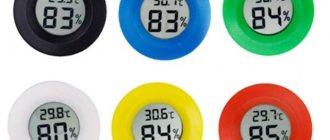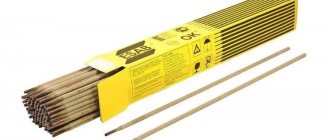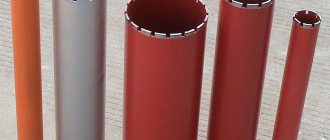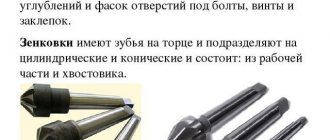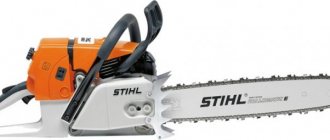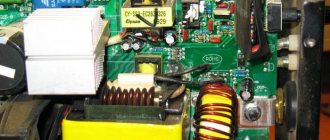The Krona 6F22 9v battery is a compact, relatively inexpensive and efficient source of electric current. Thanks to the original design of the terminals, reliable contact of the electrical wires is ensured, so this battery can be used even without a special socket.
Knowing the basic parameters of a battery, you can not only use this chemical current source in any electrical device, but also independently produce devices that will not be inferior in quality to factory-made analogues.
This article will describe in detail the technical characteristics of the battery, the possibility of replacing it with analogues, and the rules of operation and maintenance.
About the battery
The Krona 6F22 battery is a galvanic source of electric current, which, unlike most other batteries, is made in the form of a parallelepiped.
Thanks to this shape, the product remains stable in a vertical position, which, if necessary, allows the product to be used as an external power source.
Inside the Krona 6F22 battery there are six small 1.5 Volt F22 batteries, which are connected in series. The first character of the alphanumeric designation indicates precisely this feature of the battery.
Device
Krona battery device.
The first models of Krona batteries were produced with a carbon-manganese element, which was characterized by low power and large resource losses when idle. Modern Crowns are produced with an alkaline composition and are assembled from rectangular biscuits. The metal body of the battery consists of tinned steel, the platform and bottom are made of plastic. The Crown contact board consists of a negative connector (socket) and a plug. Due to this design, the Kron type power supply cannot be connected in the wrong polarity.
Specifications
All batteries have certain voltage values, energy reserves, dimensions and other important characteristics, which are best known in advance.
In order not to choose blindly when it is necessary to revive any old electrical appliance in which a battery of a similar format was installed, you should know that the “Krona” 6F22 9v has the following characteristics:
| Characteristic | Meaning |
| Form | Crown |
| View | Salt (carbon-zinc) |
| Package | Branded blister |
| Height | 48.5 mm |
| Width | 26.5 mm |
| Thickness | 17.5 mm |
| Battery capacity | 350-450 mAh |
| Rated voltage | 9v |
| Working temperature | from -40 to +50°C |
| Storage temperature | from -40 to +50°С |
| Best before date | 3 years |
| Weight | 40 gr |
Some types of batteries of this type may vary slightly in capacity. This feature is associated with the use of various electrolytes in manufacturing.
GP SuperCell Super Heavy Duty and Varta SuperLife Zinc Carbon
Application area
The Krona 6F22 battery is used in devices that require an increased voltage value, namely 9 Volts. When you open the case of the following devices, you can find this type of battery inside:
- Children's toys.
- Measuring instruments.
- Remote controls.
- Radioelectronics.
- Medical devices.
- Alarm systems.
- Flashlights.
The battery is highly resistant to adverse operating conditions, so it can be used, among other things, in military devices, such as dosimeters and communication devices.
Manufacturers
The most famous brand of Krona batteries is Energizer. The American manufacturer has been producing high-quality batteries for over 50 years. Duracell batteries are no worse in terms of power and capacity. They retain their original resource well, are durable and can operate at low temperatures.
Less popular producers of Crowns are:
Battery from Varta.
- Varta;
- GP;
- Robiton;
- Camelion.
All of them have good power and ensure stable operation of portable electrical equipment for a specified period.
Krona batteries are designed to power various compact equipment. After the capacity is used up, they can be recharged using a standard charger. Depending on the model and composition, Krona-type elements are capable of operating even at extremely low or high temperatures.
Advantages and disadvantages
Krona 6F22 9v has the following main advantages and disadvantages:
Low self-discharge.
The most budget version from Krona.
Has stable voltage.
Not high capacity.
Does not tolerate negative temperatures well.
If you are careless, you can easily close the contacts with any metal object.
Unlike batteries, which have such a parameter as diameter and can roll somewhere hard to reach, a battery of this format always remains in its place, which can also be one of its positive qualities.
Analogs and modifications
“Krona” can only be replaced by “Krona”; the only difference may be that batteries can be manufactured using different technologies. The use of one or another electrolyte can significantly affect the capacity of the battery, its weight and cost.
For example, the 6F22 differs from the 6LF22 only in that the constituent cells are salt-based batteries, unlike the second battery, which is an alkaline cell.
The following modifications of the Krona 6F22 battery are available:
| Alkaline 9v | Lithium 9v | Batteries |
| 1604A | AM6 | Nickel-cadmium 8.4 V |
| 6LF22 | PP3 | Nickel-metal hydride 8.4 V |
| 6LR61 | 522 | Li-ion 7.4 V |
| MN1604 | 6AM6 | Lithium polymer 7.4 V |
| MX1604 | ER9V | Lithium iron phosphate 7.4 V |
| Salt 9v | CR-9V | |
| 1604 | Corundum | |
| 6F22 | E-Block | |
| 6R61 | 9V Brick Battery |
All listed models can be installed in a device holder that previously used a 6LF22 battery.
What is "Krona"?
Almost everyone knows what “Krona” is. This is a nine-volt battery with a relatively small electrical capacity. What it looks like is also no secret to anyone - a parallelepiped, at one of the ends of which there are two current-carrying terminals of different shapes. This difference allows the power supply to be connected to the device with the correct polarity. The smaller diameter terminal is the positive terminal, the larger terminal is the negative terminal. In addition, polarity markings are also found on the housing. Battery Dimensions:
- height (including terminals), mm – 48.5;
- width, mm – 26.5;
- depth, mm – 17.5.
Depending on the technology (see below), the battery can contain from 3 to 7 galvanic cells.
Why is it called that?
Now about the strange name. There is a more than strange opinion spread on the Internet that the name comes from the crown of a tree. They say that the battery contacts resemble the top of a tree, and some of them allegedly have a stylized top of a Christmas tree painted on them. Agree, such a strange tree with a thick trunk and a tiny forked crown can only be imagined by a heavy smoker.
Another equally ridiculous opinion is that the battery began to be called so because of its resemblance to a monetary unit. It’s just not specified whether it’s with a bill or a coin. But both of them are just an exact copy of a battery. Where such interpretations came from is, in principle, clear. If you open a dictionary, you can find only two definitions:
- Top of a tree with leaves.
- Currency unit.
For some reason, no one bothered to find out that this battery was produced by the Soviet enterprise Krona, and this name is simply a brand taken from the name of the production association. As for the drawing, it’s not a Christmas tree, but two lightning bolts.
Agree, it looks more like lightning than the top of a Christmas tree
Initially, the battery was a salt battery. Later, with the development of appropriate technologies, alkaline ones with twice the electrical capacity appeared.
Other possible names and markings
At the same time, the same enterprise began producing batteries under the Korund brand, which were only alkaline. The size and output voltage of products from both brands are the same.
Important! Today, real “Kronas” are not produced, but their place has been taken by “Cosmos”, “Sputnik”, “Our Strength”, etc. of the same standard size and output voltage.
As for foreign manufacturers, there are a lot of companies producing batteries of a similar size, including Energizer, GP, Duracell, etc. All of them go under different trade names, but, paying tribute to the very first battery of this type, we call them “Krona batteries.” "
Today, in addition to the classic salt and alkaline Kron, the industry produces power supplies of the same size and output voltage, but manufactured using different technologies:
- Lithium iron disulfide, 6 elements.
- Manganese-lithium, 3 elements.
- Zinc air, 7 elements, before use it is necessary to depressurize the case - break off the thin plastic that sticks out between the contacts.
- Lithium thionyl chloride.
As for labeling, there are no less varieties of them than the brands of the batteries themselves:
- 1604, 6F22, 6R61 (salt);
- 1604A, 6LF22, 6LR61, MN1604, MX1604 (alkaline);
- PP3, E-Block, 9V Brick Battery, AM6, 522, 6AM6, CR-9V, ER9V (lithium).
Is it a battery or a rechargeable battery?
If we talk about the real “Krona”, then, in fact, it is a battery of galvanic cells, that is, a non-rechargeable battery. It ran out of charge and threw it away. But today there are a huge number of rechargeable batteries that are the same size but may have slightly different output voltages.
Expert opinion
Alexey Bartosh
Specialist in repair and maintenance of electrical equipment and industrial electronics.
Ask a Question
Healthy! The salt “Krona” is perhaps the only battery that can be recharged, although the manufacturer does not recommend this. If you do this periodically, without waiting for a complete discharge, the service life of the power source can be tripled.
What to look for before purchasing
Before purchasing, be sure to ensure that there are no visible signs of damage on the battery case. Even if there are minor defects, you should refuse the purchase.
Instructions and descriptions of parameters on the packaging must be deciphered if the battery is shipped from another country.
Before purchasing, you should also make sure that the product is not expired. If the guaranteed operation date has already expired, the battery should also not be purchased.
Sergey Firsov
Prototype Power Supply Specialist
Ask a Question
If you have any questions, you can ask our expert! Within a couple of days we will send you a response to the specified e-mail.
How to charge a Krona battery
Chargers available on the electrical goods market are designed to charge the battery Krona. Such devices differ in their capabilities and power ratings. However, you can make them yourself: craftsmen make such devices from cheap Chinese chargers for mobile phones.
The battery is charged with a current of 10-20 milliamps, the limit is 40 mA. The charging time is calculated using the following formula:
Charging time (in hours) = Coefficient. multiply by the capacity (in mAh) divided by the charging current. The increasing factor is selected in the range from 1.2 to 1.6 depending on the value of the charging current. The lower the current value relative to the capacitance, the greater the coefficient.
Important! You can only recharge the rechargeable Krona, that is, only when the battery is not a battery. A special designation on the body of the model indicates this. It indicates the capacity and the words “rechargeable” .
Rules of operation and disposal
When using a battery, certain rules must be followed. Despite the fact that the contacts are made for special terminals, polarity violation is also possible when trying to connect contact wires. Such actions can end disastrously for a miniature electronic device.
Do not short-circuit the battery contacts, otherwise the product will become very hot and explode. If you need to solder wires directly to the battery terminals, then it is better to use contact welding to perform this work, otherwise, due to exceeding the maximum permissible temperature, the product may also fail.
If the Krona 6F22 no longer shows signs of life, then it must be removed from the battery compartment and disposed of. Do not throw the battery in the trash. You can return a dead battery to electronics supermarkets and specialized collection points.
Lithium-ion (Li-ion) battery "Krona" 9 VReview
Lithium-ion (Li-ion) 9 V Krona battery - test and review
Contents: 1. Appearance and design 2. Tests 3. Final diagnosis and recommendations 4. Other 9 V battery options
Preface
Today we will have a difficult topic - replacing Krona format batteries with lithium-ion batteries in the same format.
Although, it seems, what’s so complicated about a battery?! However, due to the discrepancy between the required voltage (9 Volts) and the voltage of the lithium-ion battery (3.7 V), the task became completely non-trivial.
Next we will get acquainted with an interesting technical solution to this problem, but first, a historical excursion on the topic of Krona batteries (international designation - 6F22, 6R61, etc.).
Historical excursion: why was the Krona battery cool and expensive?
“Krona” is a name that has historically stuck to these 9-volt batteries since Soviet times.
These batteries looked like this:
They were terribly expensive at that time: 48 kopecks. For this money at that time you could have a very good lunch in a factory or student canteen.
They also had an improved modification called “Corundum”, which cost a crazy 60 kopecks:
These batteries were most widely used at that time in pocket transistor radios, for which they were especially revered in those days.
Soviet people were not rich enough to buy such expensive batteries; and instead of them they bought batteries of nickel-cadmium batteries called “7D-0.1” (and analogues - 7D-0.115, 7D-0.125), where the number 7 meant the number of disk “button” batteries in the battery; and the number “0.1” (0.115, 0.125) is the capacity of each “tablet” in ampere-hours.
This battery had a slightly thickened cylindrical shape, which is why it could not replace the Krona everywhere.
It must be said that Soviet “button” batteries were far from a masterpiece of technology: they often had salt deposits on the surface, and the number of their recharge cycles was small (no more than 100).
Then similar batteries appeared, fully compatible in size with the original Krona. These were the same nickel-cadmium batteries, only instead of “tablets” there were rectangular batteries. But the state of affairs with their service life has not changed for the better.
By the way, their analogues continue to be produced, and are inexpensive on Aliexpress (example).
Despite the sad circumstances listed above, the popularity of Krona batteries did not fall: a small-sized high-voltage power source was suitable for solving many problems. They are still very popular in small household appliances and measuring instruments.
And here we come close to the hero of our review, which is built on the basis of a modern lithium-polymer battery and was able to overcome all the disadvantages of its predecessors described above.
The operating principle of a 9 Volt lithium-ion (Li-ion) battery in the “Krona” format and its main parameters
Although throughout the rest of the text the device under test will be called a battery; but, you will laugh, it is not!
In fact, this is a classic power bank in its purest form, only hidden in the body of a Krona battery.
It has an input charge controller, a single cell lithium-ion battery, an output boost converter, and a charge indicator.
The only difference with conventional power banks is that in conventional power banks the output converter increases the voltage to 5 Volts, but here it is up to 9 Volts.
The tested battery is produced under the not very well-known but growing brand ZNTER.
Main technical characteristics of the ZNTER 6F22 9 Volt Li-ion battery:
| Rated output voltage | 9 V |
| Battery capacity | 400 mAh (not confirmed!) |
| Charge voltage | 5 V |
| Maximum charge current | 0.5 A |
| Charge duration | up to 2 hours |
| Maximum output current | 1 A (not confirmed!) |
| Dimensions | 48*25.6*16.6 mm |
| Weight | 26 g |
| Manufacturer's official website | www.lanbinglong.com (English-Chinese) |
The average price as of the date of review on AliExpress is $7.7; You can check the price and/or purchase here
.
In the listed characteristics, you should pay attention to the fact that the capacity supplied to the load is presumably indicated. The capacity of the installed battery will be significantly higher according to the test results.
Packaging, appearance and design of a 9-volt “Crown” lithium-ion (Li-ion) battery (ZNTER brand)
We will begin our study of the object by examining the packaging.
The packaging is a regular blister, often used for batteries:
Reverse side of the package:
Such packaging turned out to be sufficient to protect the product in transit (the outer packaging of the parcel was a simple bag with one layer of bubble wrap applied on the inside).
Now we begin to examine the patient himself.
On one side of the battery there is the manufacturer’s logo and a brief description of the product:
On the opposite side are some battery parameters:
On one of the narrow sides at the bottom there is a micro-USB port for charging the battery:
You can charge it with any 5 V charger and a micro-USB cable.
There is nothing unusual on the contact side:
And on the opposite end there is a hole for the charging indicator:
During charging, the LED on the back of the battery glows red:
When charging is complete, the LED goes out.
If the battery comes to you completely discharged, do not be alarmed. Simply, due to the sealed packaging, the seller does not have the opportunity to charge it before shipping, and during storage in the warehouse and a long journey, it could discharge itself.
This is a normal situation, and in any case, after opening the package, the battery must be charged; even if the output voltage is normal.
Technical tests of a 9 V lithium-ion (Li-ion) battery in the “Krona” format (ZNTER brand)
Now it's time to check how this battery performs.
Test program:
1. Checking the capacity pumped into the battery; maximum charging current and duration.
2. Checking the capacity supplied by the battery.
3. Checking the maximum output current and short circuit protection.
The program is simple and straightforward; let's go point by point!
To better understand the results of subsequent tests, we still need to say a few words about the internal structure of the battery (it was already mentioned above that in essence it is a power bank). Surely the reader has already begun to have questions about why a 9-volt battery is charged from a 5-volt source?!
Battery device
- not simple.
This is not just a battery, but a whole complex of devices.
In addition to the 3.7 Volt lithium-ion battery itself, it contains a charge controller circuit at the input; and at the output there is a boost converter that converts a voltage of 3.7 Volts to 9 Volts.
Such cunning transformations somewhat reduce the efficiency of the device as a whole, but they make it possible to use the most advanced battery today to produce a voltage of 9 volts: lithium-ion.
Before announcing the test results, it must be said that the battery arrived only partially charged. The voltage at the terminals turned out to be very close to the nominal value (9.36 V); but when connected to a load, it lasted only a few minutes, after which it dropped to complete zero (overdischarge protection triggered).
It seems that a lot of time passed from the time the battery was packed in the blister until it arrived at my location; and the battery managed to discharge itself.
a battery charge test was immediately carried out
. Next are its results.
Charge current
for about an hour and a half at the beginning of the charge it was 0.45...0.48 A:
This amount of charge current confirms the possibility of charging the battery from almost any telephone charger; If only it had a micro-USB cable.
About half an hour before the finish, the charge current gradually decreased until, at the moment of full charging, it dropped to zero.
The charging time from scratch was 2 hours 16 minutes, which is slightly longer than stated by the manufacturer (2 hours).
In total, the battery was charged by almost 1000 mAh. This is excellent, since it means that a quite serious lithium-polymer battery is installed inside the device.
Next - discharge tests
.
The discharge current was set at 100 mA, as a “typical” current for this type of battery, not intended for high load.
According to the laws of physics, as the voltage increases, the current decreases, so the capacity in mAh should decrease compared to the capacity “filled” in the battery. But how much it will drop and whether it will fit into the 400 mAh declared by the manufacturer - now let’s see from the test result (photo as of its completion):
It must be stated with regret that the battery did not deliver the 400 mAh promised by the manufacturer; it even fell just short of 300. But the output voltage throughout the test was maintained very close to the nominal 9 Volts.
But a very stable output voltage has both an advantage and a disadvantage.
The advantage is that it is useful for powered devices: they all love stable power.
The disadvantage is that some devices determine the power consumption based on the voltage drop on the power source and warn the user about the possible imminent depletion of charge.
Here the device will not be able to “feel” that the end of the charge is approaching and warn the user about it in time.
That is, if the battery was not recharged in time, then the cessation of operation of the powered device may be sudden and cannot be avoided .
By the way.
Next - check for maximum current output
.
The battery could not produce the maximum current of 1 A declared by the manufacturer - at a current of 0.7 Amperes, the voltage at the battery output dropped sharply.
Even a slightly lower current of 0.65 A, the battery could only hold for 1 minute.
The battery held a stable current of 0.5 A, but even at this current its operation cannot be recommended: the heating was quite strong.
Short circuit protection works - the current drops, and the device does not fail.
Final verdict: can be used at currents up to 300 mA, and no more.
With this, we consider the consultation of doctors complete and move on to the results.
Final diagnosis of a 9-volt “Krona” lithium-ion (Li-ion) battery (ZNTER brand)
The tested battery did not live up to the parameters specified by the manufacturer in all respects.
But I think the battery itself is not to blame for this; and the manufacturer is to blame for not listing the actual battery data on the website, but some numbers “out of the blue” (in order to increase demand, of course).
For the consumer, this device will, nevertheless, be very positive, if you do not demand the impossible from him.
The battery has shown its full suitability as a rechargeable power source to replace the good old Krone, although not without some comments.
Advantages
:
— the output voltage is almost exactly equal to the standard for Krona (9 V);
— high stability of output voltage;
— the amount of current supplied to the load is sufficient for almost all cases of replacing the “Krona”;
— presence of protection against overload, overdischarge and short circuit;
— presence of indication of the charging process;
— the ability to use any charger from a mobile phone to charge the tested battery;
- a large number of charge/discharge cycles (for Li-Ion batteries it is 500 - 1000).
Flaws
:
— the actual battery capacity (calculated at the device output) is lower than declared.
The final rating is good.
Special Notes
:
— the device in which the battery will operate will not issue a warning about the low remaining charge (due to the very high stability of the battery output voltage);
- Do not attempt to charge the battery in a nickel-cadmium or nickel-metal hydride battery charger (these batteries will not charge in this way).
Where can I buy
: for example, from
this seller on Aliexpress
. There you can also find batteries of other sizes that are compatible with standard batteries.
The same manufacturer produces similar Li-Ion batteries of other sizes: AAA (“little finger”), AA
(“finger”),
C
(R14),
D
(R20, element 373 in the USSR). These batteries are also charged via the micro-USB port.
If other sellers on AliExpress have the same product cheaper (due to discounts, promotions, etc.), then you can also buy it - the product is the same.
Other 9V battery options (note: the options listed below have not been tested!)
In addition to the option described in this review with a charge controller, a single-section li-ion battery and an output boost converter, there are three more options
batteries in the Krona battery format.
1. Battery in “Crown” format with 7 nickel-metal hydride cells
(mentioned above in the “historical excursion”):
(image from Aliexpress)
Nickel-metal hydride batteries generally have a slightly lower capacity than stated on the label; and their recharge cycles are significantly lower than those of lithium-ion batteries (again, regardless of what the manufacturer claims).
But they have two qualities that the consumer may like: a relatively low price and their “behavior” during operation, similar to the “behavior” of conventional batteries. The latter property can be positive in the sense that some devices will warn the user of the imminent depletion of charge based on a drop in battery voltage.
Price as of the date of review on Aliexpress - $7.4 per pair
, check the price and/or buy
here
.
2. Battery in “Crown” format with 2 lithium-ion cells without an output boost converter, but with a built-in charge controller with voltage boost from 5 V.
An example would be a Li-ion battery Palo 6F22 in the “Krona” format 9 V:
(image from Aliexpress)
Such batteries have a slightly larger capacity compared to a single-cell battery, but a lower voltage (not 9 V, as manufacturers and sellers write, but 8.4 V when fully charged (then the voltage gradually decreases as the charge is consumed).
You can also charge them using a regular phone charger.
Also among the advantages is the ability to work with a higher current load (if the user needs it).
The disadvantage is the possible underutilization of the battery capacity due to the lower voltage than in single-cell batteries with a boost converter.
Customer review from Aliexpress:
“It arrived charged to 7.8 V (two lithiums connected in series without boost); The red LED lights up during charging and the blue LED lights up when charging is complete. End of charge 8.45 V, overdischarge protection 5.5 V. The measured discharge capacity after a full charge is 470 mAh (with a discharge current of 100 mA). Charges with any phone charger with microUSB"
.
The price as of the date of review on Aliexpress is $6.7 per piece, check the price and/or buy here
.
3. Battery in the “Crown” format with 2 lithium-ion cells without voltage converters (but, I would like to believe, with an overcharge and overdischarge protection circuit).
(image from Aliexpress)
This is the simplest of batteries: two cells connected in series without any converters or indicators (but possibly with a protection circuit).
By freeing up space from different converters, they have the maximum capacity of all types of batteries to replace the “Krona” (even taking into account the peculiarities of Chinese units of capacity measurement :).
Required
separate charger.
The disadvantage is the possible underutilization of the battery capacity due to the lower voltage than in single-cell batteries with a boost converter.
Customer reviews from Aliexpress:
“It took 3.5 months to reach Moscow! A regular lithium battery, 2x4.2 V. The total when fully charged will not be higher than 8.4 V.”
“The declared capacity does not smell even after 3 charge-discharge cycles. The maximum that Imax showed was 616 mAh when discharged.”
The price as of the date of review on Aliexpress is $7 per piece, check the price and/or buy here
.
Your Doctor
.
06 October 2022 Page last updated 03/15/2021.
Join the SmartPuls.Ru Contact group! Announcements of articles and reviews, current events and thoughts about them.
Recommend this page to your friends and classmates
Comments on VKontakte:
FaceBook comments:
When copying (reprinting) materials, a link to the source (SmartPuls.ru website) is required!

